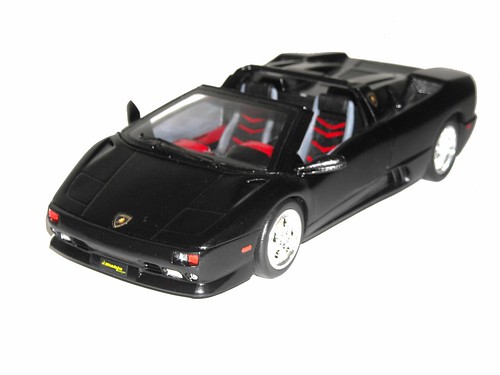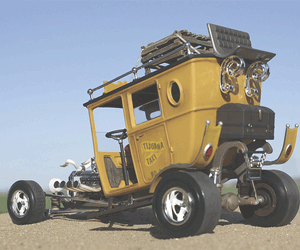Lamborghini Diablo VT Roadster 1/24 Revell SnapTite 85-1966 Review
RoR Step-by-Step Review 20111218* – Lamborghini Diablo VT Roadster 1/24 Revell SnapTite 85-1966 Review
Click Here to Buy this Kit

Â
Review and Photos by Mike Phelps 
In June1985 Automobili Lamborghini decided that it was time to start thinking about a replacement for their legendary Countach. It would take 5 yrs. to complete this. Thus the Diablo was created. The Diablo was presented to the public on January 21, 1990 at the Hotel de Paris in Monte Carlo. It would have to have the top speed of 315 Km/h but was set at 325 Km/h. The Diablo has reached up to 340 Km/h with an engine creating 492 bhp. It not only took 5 years to develop the Diablo but also 6,000,000,000 Lire went into the project.
Â

001) – This kit contains 32 pieces, one instruction manual, soft black tires, ten piece sticker sheet, one tree in clear parts, parts molded in yellow and black parts, and one tree in chrome.
Â

1816) – Even if the body is molded in the color that you want, it is always a good idea to primer and paint the body. This will cover any swirls and real light scratches or scuff marks that the plastic may have. I used Color Place fast dry interior/exterior gray primer on the body.
Â

1852) – I decided to paint this car black and build it in what is known as a Momo. This was a very limited car run. There were only 12 made world wide. It was a Mario Andretti edition so to speak. There were 6 of them painted in pearl yellow and 6 painted in metallic red. This would be my idea of what a black Momo might have looked like. I used Color Place gloss black for the body.
Â


1860 & 1861) – In these pictures it show the side vents and tail light housings. They were taped off using 3M automotive performance masking tape and then were painted using Testors One Coat Lacquer 1849M Graphite Dust spray paint to simulate the carbon fiber look.
Â

1864) – According to my research some of the Lamborghini’s wheels have the gold holes and some did not. I decided to go on and paint them using a bottle of Testors 1144 gold enamel and a sharp tipped brush. Around the lug nuts I used a bottle of Testors 1149 flat black. The excess paint was removed by using a toothpick and it was also used to bring the lug nuts back out.
Â

1874) – The interior cockpit was painted to simulate it in the Momo fashion. The paints that were used were Testors 2732 Chrysler engine red and Testors 1163 flat gray. The reason that used these colors was because they would go good with the black body. The gauges are a 1 piece sticker.Â
Â

1876) – The seats were painted in the Momo style but I decided to put the red on the seat inserts to customize it a little. Krylon gray primer spry paint was used on the seats due to the fact it is a perfect match for the Testors 1163 flat gray and touch ups woul be easy.
Â

1877) – The gear shift is installed from the bottom of the cockpit.
Â

1880) – This shows where the rear window clips into the cockpit.
Â

1881) – The instrument panel vents were painted with Testors 1146 silver and Testors 1149 flat black to bring the lines back out. A toothpick was used to do this.
Â

1886) – The engine and transmission were painted with Testors 1146 silver to give it the aluminum look.
Â

1887) – In this picture it shows the windshield. I used 3M Automobile Performance masking tape to tape off the parts that need to be clear and a hobby knife to cut out the parts that need to be painted. I used my finger nail to follow the lines that needed to be cut out. After you do so and make your cuts and peel away the tape you will have your exposed parts and ready for paint. The exposed parts should match your body color. This should be done on both sides of the windshield.
Â

1888) – The exhaust pipes were brush painted using Testors 1146 silver and Testors 1149 flat black. The exhaust pipe ends should be painted to simulate pipes.
Â

1892) – Here are the front wheel assemblies. The front and rear wheels have metal rods to allow for free rolling action. They will run through the body. The front and rear wheels snap into the tires. Now a word of caution: The metal rods may need to be glued in so they will stay on the wheels. Also there is a lot of play and the metal rods may need to be cut down to remedy this problem. A pair of side cutters works well for this.
Â

1904) – This shows the installation of the bottom of the car to the body. The body will snap into the body but it will also need to be screwed in. The screws are provided for this step.
Â

1905) – The side view mirrors will need to be painted to give it the mirror look. I used Testors 2734 silver chrome to finish the job.
Â

1916) – With respect to the lights, this kit provides stickers for the side lights and backup lights but I decided to paint them on instead. The orange that was used was Testors 1127 orange. It was used on the front of the car, the side marker lights and on the tail lights. Testors 2732 Chrysler engine red was used on the back marker lights. The backup lights and the light on the front of the car were painted using Testors 1146 silver. The instructions does say anything about the front lights but should be painted to give it a more realistic look.
                  Â
Have fun with this kit and try to keep it under 100! Â Â Â
Â
 *All Registered trademarks are the property of their respective brands.
Â


